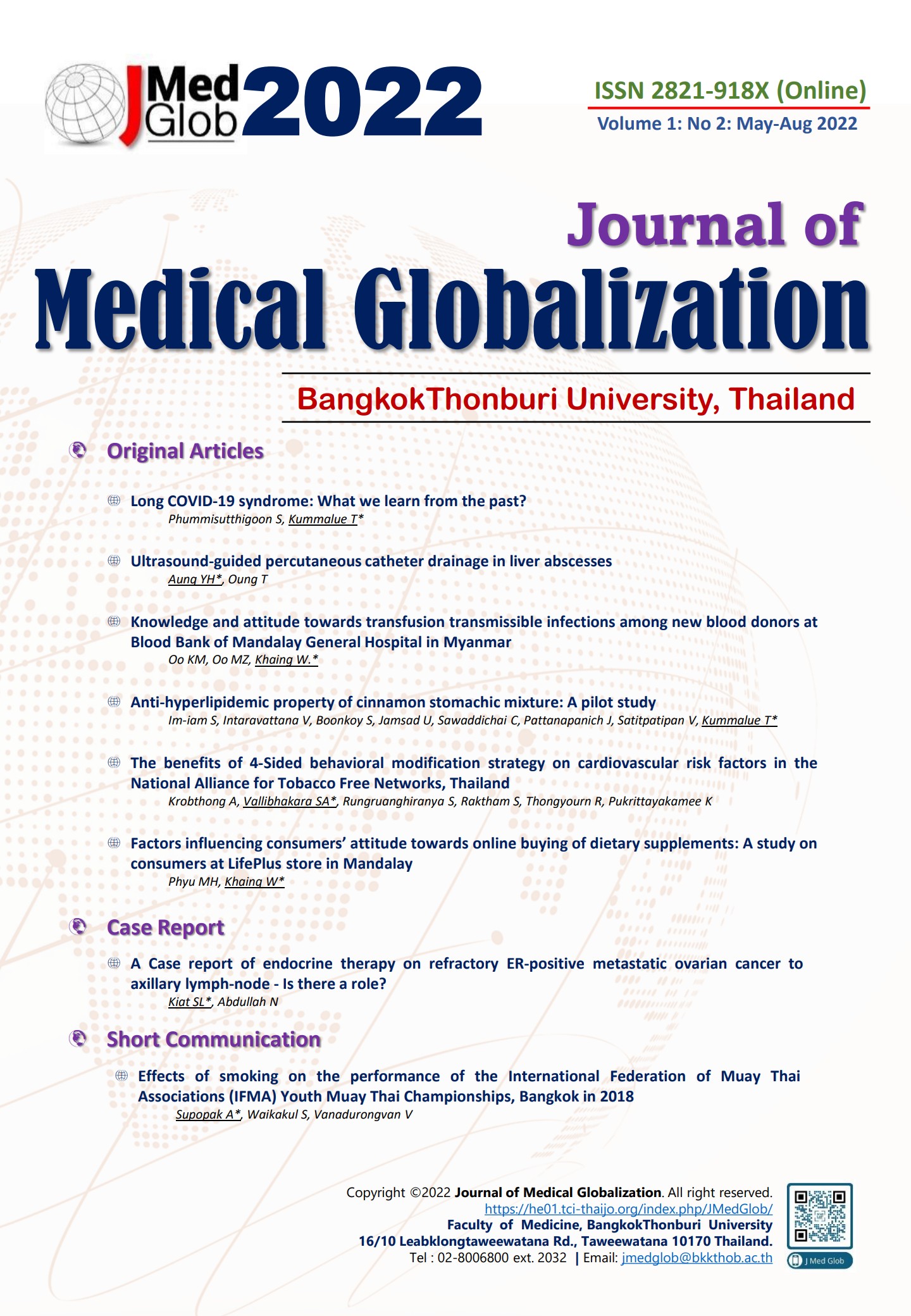Anti-hyperlipidemic Property of Cinnamon Stomachic Mixture: A Pilot Study
Keywords:
anti-hyperlipidemic property, Cinnamon stomachic mixture, hepatoprotective effectAbstract
Introduction: Cinnamon stomachic mixture, one of the Thai traditional herbal recipes, is in the National herbal drug lists in Thailand. It has long been prescribed for treating flatulence and dyspepsia. As already known, cinnamon demonstrated the potential for reducing blood lipid and glucose. In this pilot study, we investigated the anti-hyperlipidemic property of cinnamon stomachic mixture.
Materials and methods: The open-label, one single arm, prospective, pilot study was conducted at Ampur Muang District Primary Care Center, Prapokkloa Branch, Chanthaburi province, Ministry of Public Health, Thailand. Cinnamon stomachic mixture was produced from the GMP certified pharmaceutical company (Thongtong Osoth). The quality control was performed at Faculty of Pharmacy, Mahidol University. Subjects were recruited with specific inclusion and exclusion criteria. Blood chemistry including complete blood count were investigated for evaluation of the safety. All subjects were advised to take 2 tablespoons of the mixture after mealtime, 3 times daily for total 2 months. At the end of the first and second months, all subjects were asked to follow up with physical examination, blood chemistry tests, the same as done at the beginning. The anti-hyperlipidemic effects of the cinnamon stomachic mixture were assessed as the primary outcome.
Results: Based on our results, the decreasing of total blood cholesterol and triglyceride, before and after herbal recipe ingestion, was detected, but no statistical difference was observed. Other blood chemistry and complete blood count were not statistically changed. Interestingly, the statistical difference with p value = 0.034 was found in AST level, at 2 months.
Conclusion: Cinnamon stomachic mixture could reduce total cholesterol and triglyceride level, but not significant. The potent hepatoprotective property of cinnamon stomachic mixture is shown in this investigation. However, more clinical studies are still needed to be assure of the lipid lowering property of cinnamon stomachic mixture in patients with dyslipidemia.
References
Sudarat Homhual. Thaicrudedrug.com [Internet]. Available online: http://www.thaicrudedrug.com/main.php?action=viewpage&pid=149.
Rao PV, Gan SH. Cinnamon: A multifaceted medicinal plant. Evidence-based Complement Alter Med. 2014.
Tangjitjaroenkun J, Tangchitcharoenkhul R, Yahayo W, Supabphol S, Sappapan R, Supabphol R. Chemical compositions of essential oils of Amomum verum and Cinnamomum parthenoxylon and their in vitro biological properties. J Herbmed Pharmacol. [Internet]. Available online: doi:10.34172/jhp.2020.29.
Lim TK. Glycyrrhiza glabra. Edible medicinal and non-medicinal plants. 2015;Oct 22:354-457.
Akbar S. Glycyrrhiza glabra L. Handbook of 200 Medicinal Plants. pp 963-980. [Internet]. Available online: https://link.springer.com/chapter/10.1007/978-3-030-16807-0_103.
Sudarat Homhual. Thaicrudedrug.com [Internet]. Available online: http://www.thaicrudedrug.com/main.php?action=viewpage&pid=163.
Batiha G, Alkazmi L, Wasef L, Beshbishy A, Nadwa E, Rashwan E. Syzygium aromaticum L.: Traditional uses, bioactive chemical constituents, pharmacological and toxicological activities. Biomolecules. 2020;10:202.
Jindarat S, Muangnoi C, Changsiriporn D, Platong A, Thanamontra B, Chiewchanwit D, et al. Efficacy and safety of Cinnamon Stomachic mixture for patients with functional dyspepsia. Siriraj Med J. 2006;58:1103-6.
Javed I, Faisal I, Zia Ur, Khan M, Muhammad F, Aslam B, Ahmad M, Shahzadi A. Lipid lowering effect of cinnamomum zeylanicum in hyperlipidaemic albino rabbits. Pak J Pham Sci. 2012;25:141-7.
Ranasinghe P, Perera S, Gunatilake M, Abeywardene E, Gunapala N, Premakumara S, et al. Effects of Cinnamomum zeylanicum (Ceylon cinnamon) on blood glucose and lipids in a diabetic and healthy rat model. Pharmacognosy Res. 2012;4(2):73-9.
Ranasinge P, Jayawardanan R, Galappaththy P, Constantine GR, Gunawardana N, Katulanda P. Efficacy and safety of “true” cinnamon (cinnamomum zeylanicum) as a pharmaceutical agent in diabetes: A systemic review and meta-analysis. Diab Med. 2012;29:1480-92.
Askari F, Rashidkhani B, Hekmatdoost A. Cinnamon may have therapeutic benefits on lipid profile, liver enzymes, insulin resistance, and high-sensitivity C-reactive protein in nonalcoholic fatty liver disease. Nut Res. 2014;34:143-8.
Ranasinghe P, Jayawardena R, Pigera S, Wathurapatha W, Weeratunga H, Premakumara A, et al. Evaluation of pharmacodynamic properties and safety of Cinnamomum zeylanicum (Ceylon cinnamon) in healthy adults: a phase I clinical trial. BMC Complement Altern Med. 2017;17(1):550.
Vafa M, Mohammadi F, Shidfar F, Sormaghi M, Heidari I, Golestan B, et al. Effects of cinnamon consumption on glycemic status, lipid profile and body composition in Type 2 Diabetic patients. Int J Prev Med. 2012. [Internet]. Avalilable online. https://www.ncbi.nlm.nih.gov/pmc/articles/PMC3429799/pdf/IJPVM-3-531.pdf.
Maierean S, Serban M, Sahebkar A, Ursoniu S, Serban A, Penson P, et al. The effects of cinnamon supplementation on blood lipid concentrations: A systemic review. J Clin Lipidol. 2017;11(6):1393-406.
Jamali N, Kazemi A, Chaleshtori J, Najaf M, Mohammadi V, Clark C. The effect of cinnamon supplementation on lipid profiles in patients with type 2 diabetes: A systemic review and meta-analysis of clinical trials. Complement Ther Med. 2020;55.
Jain S, Puri S, Misra A, Gulati S, Mani K. Effect of oral cinnamon intervention on metabolic profile and body composition of Asian Indians with metabolic syndrome: A randomized double-blind control trial. Lipids Health Dis. 2017;16:113.
Burg J, Espenshade P. Regulation of HMG-CoA reductase in mammals and yeast. Prog Lipid Res. 2011;50(4):403-10.
Eidi A, Mortazavi P, Bazargan M, Zaringhalam J. Hepatoprotective activity of cinnamon ethanolic extract against CCL4-induced liver injury in rats. EXCLI J. 2012;11:495-507.
Roussel A, Hininger I, Benaraba R, Ziegenfuss T, Anderson R. Antioxidant effects of a cinnamon extract in people with impaired fasting glucose that are overweight or obese. J Am Coll Nutr. 2009;28:16-2
Published
How to Cite
Issue
Section
License
Copyright (c) 2022 Journal of Medical Globalization

This work is licensed under a Creative Commons Attribution-NonCommercial 4.0 International License.








